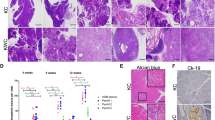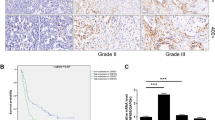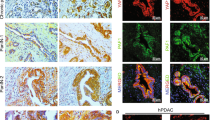Abstract
Potassium channel modulatory factor 1 (KCMF1) was found upregulated in a differential screen in the metaplastic epithelium in the pancreas of transforming growth factor (TGF)-α transgenic mice. Expression analysis indicated broad overexpression in human cancer tissues. Therefore, we investigated the hypothesis that KCMF1 promotes metaplastic changes and tumor development. KCMF1 represents an evolutionarily highly conserved protein with a 95% identity between human and zebrafish. KCMF1 is expressed during embryonic development and in the majority of adult tissues investigated. Upregulation of nuclear KCMF1 expression is evident in preneoplastic lesions and in several epithelial malignancies, such as pancreatic cancer in mice and humans. In cell culture and in the chicken chorioallantoic membrane model, KCMF1 enhances proliferation, migration and invasion of HEK-293 and Panc1 cells. In crossbreeding experiments, KCMF1-knockdown gene trap mice showed a reduced number and size of premalignant lesions and absence of pancreatic cancer formation in TGF-α transgenic mice. This effect is related to the decreased expression of G1 to S cell-cycle regulators such as cyclin D and cyclin-dependent kinase (CDK) 4. Our data support the hypothesis that KCMF1 mediates pro-oncogenic functions in vitro and in vivo and downregulation of KCMF1 results in the inhibition of pancreatic cancer formation in mice. These effects are mediated through downregulation of cell-cycle control genes such as cyclin D and CDK4.
This is a preview of subscription content, access via your institution
Access options
Subscribe to this journal
Receive 50 print issues and online access
$259.00 per year
only $5.18 per issue
Buy this article
- Purchase on Springer Link
- Instant access to full article PDF
Prices may be subject to local taxes which are calculated during checkout






Similar content being viewed by others
Abbreviations
- CAM:
-
chorioallantoic membrane
- CDK4:
-
cyclin-dependent kinase 4
- FGF:
-
fibroblast growth factor
- KCMF1:
-
potassium channel modulatory factor 1
- PanIN:
-
pancreatic intraepithelial neoplasia
- RT–PCR:
-
real-time PCR
- TGF-α:
-
transforming growth factor alpha
References
Aguirre AJ, Bardeesy N, Sinha M, Lopez L, Tuveson DA, Horner J et al. (2003). Activated Kras and Ink4a/Arf deficiency cooperate to produce metastatic pancreatic ductal adenocarcinoma. Genes Dev 17: 3112–3126.
Almoguera C, Shibata D, Forrester K, Martin J, Arnheim N, Perucho M . (1988). Most human carcinomas of the exocrine pancreas contain mutant c-K-ras genes. Cell 53: 549–554.
Ambros IM, Ambros PF, Strehl S, Kovar H, Gadner H, Salzer-Kuntschik M . (1991). MIC2 is a specific marker for Ewing's sarcoma and peripheral primitive neuroectodermal tumors. Evidence for a common histogenesis of Ewing's sarcoma and peripheral primitive neuroectodermal tumors from MIC2 expression and specific chromosome aberration. Cancer 67: 1886–1893.
Barton CM, Hall PA, Hughes CM, Gullick WJ, Lemoine NR . (1991). Transforming growth factor alpha and epidermal growth factor in human pancreatic cancer. J Pathol 163: 111–116.
Caldas C, Hahn SA, Hruban RH, Redston MS, Yeo CJ, Kern SE . (1994). Detection of K-ras mutations in the stool of patients with pancreatic adenocarcinoma and pancreatic ductal hyperplasia. Cancer Res 54: 3568–3573.
Chen HZ, Tsai SY, Leone G . (2009). Emerging roles of E2Fs in cancer: an exit from cell cycle control. Nat Rev Cancer 9: 785–797.
de Alava E . (2007). Molecular pathology in sarcomas. Clin Transl Oncol 9: 130–144.
Ghaneh P, Sultana A, Shore S, Stocken D, Neoptolemos J . (2006). The case for adjuvant chemotherapy in pancreatic cancer. Best Pract Res Clin Gastroenterol 20: 383–401.
Gillett C, Smith P, Gregory W, Richards M, Millis R, Peters G et al. (1996). Cyclin D1 and prognosis in human breast cancer. Int J Cancer 69: 92–99.
Hahn SA, Hoque AT, Moskaluk CA, da Costa LT, Schutte M, Rozenblum E et al. (1996). Homozygous deletion map at 18q21.1 in pancreatic cancer. Cancer Res 56: 490–494.
Hall M, Peters G . (1996). Genetic alterations of cyclins, cyclin-dependent kinases, and Cdk inhibitors in human cancer. Adv Cancer Res 68: 67–108.
Hingorani SR, Petricoin EF, Maitra A, Rajapakse V, King C, Jacobetz MA et al. (2003). Preinvasive and invasive ductal pancreatic cancer and its early detection in the mouse. Cancer Cell 4: 437–450.
Hruban RH, Adsay NV, Albores-Saavedra J, Compton C, Garrett ES, Goodman SN et al. (2001). Pancreatic intraepithelial neoplasia: a new nomenclature and classification system for pancreatic duct lesions. Am J Surg Pathol 25: 579–586.
Jaffee EM, Hruban RH, Canto M, Kern SE . (2002). Focus on pancreas cancer. Cancer Cell 2: 25–28.
Jang JH . (2004). FIGC, a novel FGF-induced ubiquitin-protein ligase in gastric cancers. FEBS Lett 578: 21–25.
Johnson DG, Schwarz JK, Cress WD, Nevins JR . (1993). Expression of transcription factor E2F1 induces quiescent cells to enter S phase. Nature 365: 349–352.
Khasawneh J, Schulz MD, Walch A, Rozman J, Hrabe de Angelis M, Klingenspor M et al. (2009). Inflammation and mitochondrial fatty acid beta-oxidation link obesity to early tumor promotion. Proc Natl Acad Sci USA 106: 3354–3359.
Kreppel M, Aryee DN, Schaefer KL, Amann G, Kofler R, Poremba C et al. (2006). Suppression of KCMF1 by constitutive high CD99 expression is involved in the migratory ability of Ewing's sarcoma cells. Oncogene 25: 2795–2800.
Kuefer R, Hofer MD, Altug V, Zorn C, Genze F, Kunzi-Rapp K et al. (2004). Sodium butyrate and tributyrin induce in vivo growth inhibition and apoptosis in human prostate cancer. Br J Cancer 90: 535–541.
Li Z, Stuart RO, Eraly SA, Gittes G, Beier DR, Nigam SK . (2003). Debt91, a putative zinc finger protein differentially expressed during epithelial morphogenesis. Biochem Biophys Res Commun 306: 623–628.
Maitra A, Hruban RH . (2008). Pancreatic cancer. Annu Rev Pathol 3: 157–188.
Mendez J . (2009). Temporal regulation of DNA replication in mammalian cells. Crit Rev Biochem Mol Biol 44: 343–351.
Miyamoto Y, Maitra A, Ghosh B, Zechner U, Argani P, Iacobuzio-Donahue CA et al. (2003). Notch mediates TGF alpha-induced changes in epithelial differentiation during pancreatic tumorigenesis. Cancer Cell 3: 565–576.
Molenaar JJ, Ebus ME, Koster J, van Sluis P, van Noesel CJ, Versteeg R et al. (2008). Cyclin D1 and CDK4 activity contribute to the undifferentiated phenotype in neuroblastoma. Cancer Res 68: 2599–2609.
Nakhai LA, Mohammadirad A, Yasa N, Minaie B, Nikfar S, Ghazanfari G et al. (2007). Benefits of Zataria multiflora Boiss in experimental model of mouse inflammatory bowel disease. Evid Based Complement Alternat Med 4: 43–50.
Sandgren EP, Luetteke NC, Qiu TH, Palmiter RD, Brinster RL, Lee DC . (1993). Transforming growth factor alpha dramatically enhances oncogene-induced carcinogenesis in transgenic mouse pancreas and liver. Mol Cell Biol 13: 320–330.
Sherr CJ, Roberts JM . (1999). CDK inhibitors: positive and negative regulators of G1-phase progression. Genes Dev 13: 1501–1512.
Thayer SP, di Magliano MP, Heiser PW, Nielsen CM, Roberts DJ, Lauwers GY et al. (2003). Hedgehog is an early and late mediator of pancreatic cancer tumorigenesis. Nature 425: 851–856.
Tosh D, Slack JM . (2002). How cells change their phenotype. Nat Rev Mol Cell Biol 3: 187–194.
Wagner M, Greten FR, Weber CK, Koschnick S, Mattfeldt T, Deppert W et al. (2001). A murine tumor progression model for pancreatic cancer recapitulating the genetic alterations of the human disease. Genes Dev 15: 286–293.
Wagner M, Lopez ME, Cahn M, Korc M . (1998a). Suppression of fibroblast growth factor receptor signaling inhibits pancreatic cancer growth in vitro and in vivo. Gastroenterology 114: 798–807.
Wagner M, Luhrs H, Kloppel G, Adler G, Schmid RM . (1998b). Malignant transformation of duct-like cells originating from acini in transforming growth factor transgenic mice. Gastroenterology 115: 1254–1262.
Wagner M, Weber CK, Bressau F, Greten FR, Stagge V, Ebert M et al. (2002). Transgenic overexpression of amphiregulin induces a mitogenic response selectively in pancreatic duct cells. Gastroenterology 122: 1898–1912.
Yamamoto M, Tamakawa S, Yoshie M, Yaginuma Y, Ogawa K . (2006). Neoplastic hepatocyte growth associated with cyclin D1 redistribution from the cytoplasm to the nucleus in mouse hepatocarcinogenesis. Mol Carcinog 45: 901–913.
Acknowledgements
We thank Jessica Wegele and Uschi Möhnle for excellent technical assistance. This work was supported by the Deutsche Forschungsgemeinschaft (SFB518: A10 to MW, A18 to FO and B23 to TW). We thank all the participating members of the SFB518 for helpful discussions, advices and materials.
Author information
Authors and Affiliations
Corresponding author
Ethics declarations
Competing interests
The authors declare no conflict of interest.
Additional information
Supplementary Information accompanies the paper on the Oncogene website
Supplementary information
Rights and permissions
About this article
Cite this article
Beilke, S., Oswald, F., Genze, F. et al. The zinc-finger protein KCMF1 is overexpressed during pancreatic cancer development and downregulation of KCMF1 inhibits pancreatic cancer development in mice. Oncogene 29, 4058–4067 (2010). https://doi.org/10.1038/onc.2010.156
Received:
Revised:
Accepted:
Published:
Issue Date:
DOI: https://doi.org/10.1038/onc.2010.156



